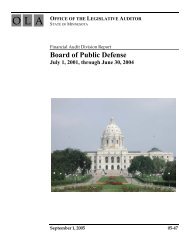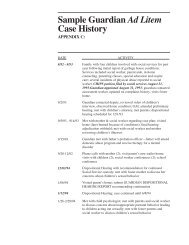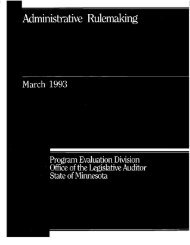Occupational Regulation - Office of the Legislative Auditor
Occupational Regulation - Office of the Legislative Auditor
Occupational Regulation - Office of the Legislative Auditor
Create successful ePaper yourself
Turn your PDF publications into a flip-book with our unique Google optimized e-Paper software.
APPENDIX B 93<br />
<strong>of</strong>fered by proponents <strong>of</strong> licensure. Ironically, <strong>the</strong> educational requirements also<br />
served as <strong>the</strong> greatest impediment to <strong>the</strong> 1997 proposal. Among <strong>the</strong> most forceful<br />
opposition to <strong>the</strong> bill was a diverse group <strong>of</strong> alternative medical practitioners,<br />
many who use <strong>the</strong> title “naturopath.” Most if not all naturopaths who actively<br />
opposed <strong>the</strong> proposal would not have met <strong>the</strong> educational requirements, and<br />
feared possible restrictions on <strong>the</strong>ir practices if <strong>the</strong> proposal passed. Ultimately,<br />
<strong>the</strong> 1997 proposal received hearings but did not win approval. However, it did<br />
provide impetus for a report on Complimentary and Alternative Medicine by <strong>the</strong><br />
Minnesota Department <strong>of</strong> Health, which concluded that <strong>the</strong>re is not presently<br />
enough information to justify government regulation <strong>of</strong> naturopaths or o<strong>the</strong>r<br />
alternative medical providers. 11<br />
The case <strong>of</strong> naturopathic doctors reveals some <strong>of</strong> <strong>the</strong> difficulty that smaller<br />
pr<strong>of</strong>essional groups face in attempting to gain state regulation. Given that <strong>the</strong><br />
most vocal opposition to <strong>the</strong> bill came from o<strong>the</strong>r practitioners <strong>of</strong> naturopathy, <strong>the</strong><br />
proposal to license “qualified” naturopathic doctors also illustrates <strong>the</strong> way<br />
occupational regulation can be used to “fence out” potential competitors.<br />
However, <strong>the</strong> same could be said <strong>of</strong> <strong>the</strong> long-established regulation <strong>of</strong> medical<br />
doctors: <strong>the</strong> medical doctors’ practice act effectively prevents naturopathic<br />
physicians from exercising <strong>the</strong> full scope <strong>of</strong> practice in which <strong>the</strong>y have been<br />
trained.<br />
The case <strong>of</strong> naturopaths also provides an example <strong>of</strong> <strong>the</strong> Legislature using a report<br />
to inform its decisions regarding occupational regulation. In some ways this<br />
demonstrates <strong>the</strong> ability <strong>of</strong> <strong>the</strong> Legislature to implement studies on an “as needed”<br />
basis, which would seem to negate <strong>the</strong> need to establish a more institutionalized<br />
sunrise review process, as we recommend in Chapter 3. However, <strong>the</strong> report<br />
casted a broad net and concluded with a blanket recommendation against<br />
regulating any <strong>of</strong> <strong>the</strong> pr<strong>of</strong>essions providing complementary and alternative<br />
medical services. While <strong>the</strong> report does represent a laudable attempt to bring<br />
more objective reasoning to bear on <strong>the</strong> issue, it was not focused on <strong>the</strong> particular<br />
proposal at hand, as was <strong>the</strong> more useful HSOAC report issued in response to <strong>the</strong><br />
1987 proposal.<br />
NURSING<br />
Nursing is one <strong>of</strong> <strong>the</strong> oldest regulated pr<strong>of</strong>essions in Minnesota. The pr<strong>of</strong>ession<br />
was first licensed in 1907 and is currently one <strong>of</strong> <strong>the</strong> largest regulated pr<strong>of</strong>essions<br />
in <strong>the</strong> state. The Board <strong>of</strong> Nursing licenses about 80,000 registered nurses and<br />
licensed practical nurses. Like <strong>the</strong> entire health care system, <strong>the</strong> nursing<br />
pr<strong>of</strong>ession has undergone many changes in recent years. The advent <strong>of</strong> new<br />
technology and new health service organizations has increased <strong>the</strong> role <strong>of</strong> nurses,<br />
and less trained health workers are now performing some <strong>of</strong> <strong>the</strong> duties previously<br />
reserved for nurses. These changes were <strong>the</strong> impetus for two bills presented to <strong>the</strong><br />
Legislature in 1997.<br />
11 Complementary Medicine: A Report to <strong>the</strong> Legislature. The study was mandated through an<br />
amendment to <strong>the</strong> 1997 Omnibus Health and Human Services Appropriations Act - Minn. Laws<br />
(1997) ch. 203, sec. 3, subd. 2.








